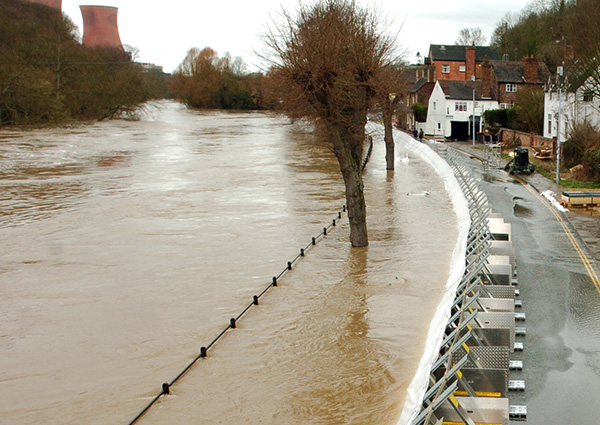News
Prepare For Floods This Winter, UK Communities Warned
Flood Action Week has just come to a close, held between November 7th and 13th, with the aim being to encourage those who live in places with high risk of flooding to take action now so as to protect their property, belongings and family over the winter months.
While the UK saw some of the highest temperatures ever recorded this year, with the Met Office confirming that England experienced its joint hottest summer ever and drought conditions persisting around the country, we’re now expecting an increase in wet and windy weather… and flooding could take place at any time.
Since 1998, six of the ten wettest years on record have been seen in England and 2022 saw three named storms batter the country in just one week… the first time this has happened. As such, the importance of planning and preparing for increasingly extreme and more regular events is becoming more and more apparent as time goes on.
The effects of climate change and the realities of what rising global temperatures mean for countries all over the world are becoming clearer and clearer. We’ve seen wildfires take hold across Europe, China’s in the grips of its worst heatwave in decades and Pakistan has been devastated by flooding, with over 1,500 people killed and millions more displaced.
To help communities in the UK protect themselves, their families and their homes and businesses, the Environment Agency is now calling on people to check what their flood risk is (which can be done online), as well as signing up for flood warnings and knowing what action to take if a flood does strike.
The Agency has also just expanded its flood warning service to include almost 50,000 new properties, with the aim being to exceed its target and provide such capabilities for 62,000 properties facing flood risks this winter. This would bring the number of registered properties to 1.6 million.
Over the last 12 months or so, £5.2 billion has also been invested in flood and coastal protective measures, including the construction and repair of flood defences. There are also more than 250 mobile pumps available and 5,000 trained specialists across the country to ensure that action can be taken wherever it’s needed over the coming weeks and months.
At least one in six people in England are currently at risk from inland and coastal flooding, with many more facing risks posed by surface water flooding. Despite this, however, almost two in three households who do face flooding risks don’t believe it will happen to them. And some 1.5 million at-risk households are yet to put any preparation plans in place just in case.
The advice is to Prepare. Act. Survive…
In the event of an initial flood alert, pack medication, insurance and important documentation before visiting the flood warning information service.
If there is a confirmed flood warning, act by moving family, pets and belongings somewhere safe, turning off the gas, water and electricity.
And if there is a severe flood warning, follow the advice of emergency services or call 999 to survive immediate danger.
A warning has also been issued to motorists not to attempt driving through flood water and take additional precautions during wet weather, since just 30cm of flowing water is enough to float a car.
Caroline Douglass, executive director of flooding at the Environment Agency, said: “Climate change is happening now. We’re seeing more extreme weather – in this year alone with three named storms in a week, record-breaking temperatures and drought declared across large parts of the country.
“That is why it is vital that people take the necessary preparations as early as possible to prepare for the worst. Our recent investment programme has better protected 314,000 homes from flooding and we’re investing millions into keeping communities safe, but we can’t stop all flooding.
“The message is clear – households risk ignoring the danger of flooding at their own peril. Anyone can go online to check if they are at risk, sign up for Environment Agency warnings, and, most importantly, know what you need to do if flooding hits.”
How can businesses protect themselves against flooding?
Floods can be devastating if they hit your home or business, but there are steps you can take to prepare and ensure that your property is as protected as possible.
For businesses, flooding can really take its toll, causing serious disruption through damaged stock, loss of custom, supply chain disruption, loss of power and many other ongoing costs if you have to close for repairs.
Although you can’t eliminate the risks of flooding entirely, you can mitigate the effects by preparing for them appropriately.
Firstly, gaining a deeper understanding of the flood risk in your area is a good initial step to take, even if you’ve been operating from your current site for years and think you know it well. Some areas are inevitably more at risk than others, so if you’re near a river that could potentially overflow it’s particularly important to check your long-term flood risks.
Once you know what your flood risk is, you can start thinking about how best to go about protecting your assets.
Moving essential business equipment, important documents and so on to a higher level is advisable, as is investing in flood-resistant upgrades, flood barriers and protection measures. Installing a non-return valve in the sewer pipes can also afford you some protection, while elevating electrical sockets and wiring can improve safety standards.
Writing a flood plan can help steer you in the right direction during an emergency. Include contact information for all relevant helplines, including your energy providers and your local council. The action required in case of an evacuation could also be useful details to include.
Interested in commercial water recycling? Get in touch with H2o Building Services today.
